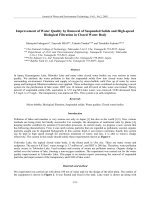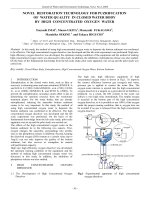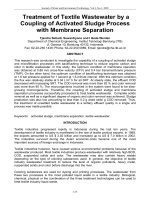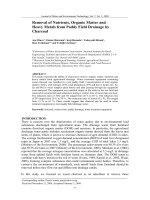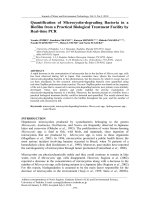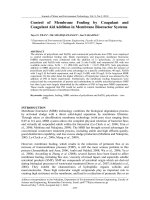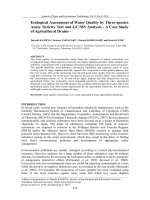- Trang chủ >>
- Khoa Học Tự Nhiên >>
- Vật lý
Boosting biogas yield of anaerobic digesters by utilizing concentrated molasses from 2nd generation bioethanol plant
Bạn đang xem bản rút gọn của tài liệu. Xem và tải ngay bản đầy đủ của tài liệu tại đây (248.62 KB, 12 trang )
I
NTERNATIONAL
J
OURNAL OF
E
NERGY AND
E
NVIRONMENT
Volume 4, Issue 2, 2013 pp.199-210
Journal homepage: www.IJEE.IEEFoundation.org
ISSN 2076-2895 (Print), ISSN 2076-2909 (Online) ©2013 International Energy & Environment Foundation. All rights reserved.
Boosting biogas yield of anaerobic digesters by utilizing
concentrated molasses from 2
nd
generation bioethanol plant
Shiplu Sarker
1
, Henrik Bjarne Møller
2
1
Department of Renewable Energy, Faculty of Engineering and Science, University of Agder, Grimstad-
4879, Norway.
2
Department of Biosystems Engineering, Faculty of Science and Technology, Aarhus University,
Research center Foulum, Blichers Allè, Post Box 50, Tjele-8830, Denmark.
Abstract
Concentrated molasses (C
5
molasses) from 2
nd
generation bioethanol plant has been investigated for
enhancing productivity of manure based digesters. A batch study at mesophilic condition (35±1°C)
showed the maximum methane yield from molasses as 286 LCH
4
/kgVS which was approximately 63%
of the calculated theoretical yield. In addition to the batch study, co-digestion of molasses with cattle
manure in a semi-continuously stirred reactor at thermophilic temperature (50±1°C) was also performed
with a stepwise increase in molasses concentration. The results from this experiment revealed the
maximum average biogas yield of 1.89 L/L/day when 23% VS
molasses
was co-digested with cattle manure.
However, digesters fed with more than 32% VS
molasses
and with short adaptation period resulted in VFA
accumulation and reduced methane productivity indicating that when using molasses as biogas booster
this level should not be exceeded.
Copyright © 2013 International Energy and Environment Foundation - All rights reserved.
Keywords: Molasses; 2
nd
generation bio-ethanol plant; Anaerobic digesters; Biogas yield.
1. Introduction
The overwhelming dependence on fossil fuel and the escalating greenhouse gas emissions are the two
concerns heavily contributing in rearranging most of the energy policies worldwide. In response to that,
European energy council, has set a target of 20% renewable energy in proportion of total energy
consumption and 10% bio-fuels in proportion of total fuel consumption by the year 2020 [1]. Coupled
with policies and regulations, technologies encompassing renewable energy have also been diversified.
Deploying lignocellulosic biomass for the production of bioethanol (2
nd
generation bioethanol) [2], is one
example in that direction.
Conventionally, ethanol as a vehicle fuel is produced from different sources of biomass(sugar cane, corn,
gain, rice etc), predominantly containing lower and higher carbohydrates [3]. Bioethanol plants dealing
with biomass rich in sucrose and starch are termed as first generation plants [2]. Although majority of the
World’s ethanol is processed in first generation bio-ethanol plants, their negative impact to the
environment has recently been brought into serious consideration. Competition with food or feed for
fertile land and thereby increasing food prices is one of the long lasting dilemmas in regards of 1
st
generation ethanol industries [4]. Issues like eutrophication and acidification caused by high energy
fossil fuel input for fertilization of ethanol feedstocks are also believed as the outcome of such ethanol
International Journal of Energy and Environment (IJEE), Volume 4, Issue 2, 2013, pp.199-210
ISSN 2076-2895 (Print), ISSN 2076-2909 (Online) ©2013 International Energy & Environment Foundation. All rights reserved.
200
plants [5]. Avoiding these limitations yet maintaining continuously rising ethanol demand is a challenge
to combat for which alternative solution is necessary. Second generation bio-ethanol plant (primarily
based on agricultural and industrial residues), is potentially offering the solution of these burning issues
of food or fuel while providing opportunities for the treatment of low value wastes and therefore is
expected to play a vital role in the coming years.
Rooted in the notion of 2
nd
generation bio-ethanol plant, from the year 2003 and onward Inbicon A/S,
Denmark developed the EU project idea of Integrated biomass utilization system (IBUS) [6] to convert
lignocellulosic biomass into bio-ethanol. Since inception, extensive effort has been paid for the further
improvement of its different aspects and now reached to the edge of a commercial reality [6]. Principally,
the Inbicon A/S plant produces bio-ethanol from wheat straw by five processing steps i) pre-treatment ii)
hydrolysis iii) fermentation iv) distillation and v) separation and uses solely steam and enzyme for the
entire process. Pre-treatment, as an important part of this process itself is divided into two lines where
one line is operating with lower capacity (100 kg biomass/hour) for the purpose of research, in contrast
with the other with a higher capacity (1000 kg biomass/hour) for the purpose of mechanical
development.
C
5
molasses as a by-product resulted from two of the above process streams. It is obtained as a residue
either after pre-treatment or after separation. Characteristically, C
5
molasses is different depending on the
point they are originated and on the qualities of the wheat straw it was derived from. Molasses originated
after the pre-treatment unit was concentrated by the evaporation of water to enrich in dry matter content
and used for this study. Previously, molasses was primarily used for animal feeding. But considering its
storage potential and high degradability, it is recently exploited for anaerobic digestion also. Anaerobic
digestion of molasses with a low dry-matter content of 4.4% that derived from the processing stream as
described by Thomsen et al, 2008 was documented by Kaparaju et al, 2009 [7]. However, biogas
production from molasses with a very high dry matter content (58%) has not been investigated before to
the present knowledge of the authors.
Substrate with high dry-matter content is generally suitable for co-digestion which treats two or more
materials with complementary attributes. Despite several advantages that include higher biogas
production, lesser inhibition as well as higher buffering [8], the successful adoption of co-digestion
strategy is challenged by the issue of scarcity of concentrated biomass that can be stored and utilized all
around the year to meet the seasonal variation in energy demand. Biogas plant connected with CHP
(combined heat and power plant) is typically designed for base load due inadequacy of the material
characterized to boost the energy production when peak load is demanded. Generally, peak load is met
from other source of energy often in fossil fuel nature. However, major effort has strongly been applied
to substitute this concept and by displacing fossil fuel from the fuel renewable in nature. Considering
this, the feasibility of utilizing concentrated C
5
molasses for biogas production and short term boosting of
methane yield was examined in semi-continuously fed reactors. Together, the methane potential of C
5
molasses was measured in batch study.
2. Materials and methods
2.1 C
5
molasses
C
5
molasses, a by-product of a bio-ethanol industry [6], was obtained from a second generation bio-
ethanol demonstration plant (Inbicon A/S, Kalundborg, Denmark) and used as a substrate for co-
digestion in this study. It contains a high amount of oligosaccharides and sugars due to the breakdown of
hemicelluloses during processing of input biomass (wheat straw). The physical and chemical properties
of molasses (C
5
molasses) are given in Table 1.
2.2 Dairy cattle manure
Dairy cattle manure (DCM) was obtained from slurry reception tank at Research Center Foulum,
Denmark, during February until March 2011. The average properties of slurry, collected several times
during the experimental period, were: pH=7.7±0.5; Total Nitrogen =3.6±0.6%; Total Solid (TS) =
8.7±0.6, Volatile Solid (VS) =7.5±0.3 and Total ammonia nitrogen (TAN) =1.91±0.2 respectively.
2.3 Inoculum
Two types of inoculum was used for this study, thermophilic inoculum for the continuous reactors and
mesophilic inoculum for the batch reactors. Effluent from main digester of biogas plant at research center
Foulum (Denmark) was employed as thermophilic inoculum. The main digester operates at thermophilic
International Journal of Energy and Environment (IJEE), Volume 4, Issue 2, 2013, pp.199-210
ISSN 2076-2895 (Print), ISSN 2076-2909 (Online) ©2013 International Energy & Environment Foundation. All rights reserved.
201
temperature (50±1.0°C) and treats various materials such as pig manure, cattle manure, maize silage and
industrial wastes together. Average TS, VS, pH and TAN of thermophilic inoculum was measured as
3.6±0.5% , 2.2±0.5%, 8.3 and 0.5g/L respectively. Mesophilic inoculum, on the other hand, was
collected from the same facility however from post digester tank where the digested slurry from the main
reactor had been stored at a temperature of 35±0.5°C for further de-gasification. The properties of
mesophilic inoculum when measured were TS=2.83±0.5%, VS=1.43±0.5%, pH= 8.1±0.4 and
TAN=1.82±0.5 g/L respectively.
Table 1. Properties of C
5
molasses
Properties Amount
Density (L/kg) 1.3
pH 4.2
TS (% w/w) 58.1
VS (% w/w) 43.0
Ash (% of TS)
a
26.0
Ash (% of TS)
b
19.0
Lipids (g/kg TS) 0.197
VFA (g/l) 25.4
Acetate (g/l) 24.8
Propionate (g/l) 0.412
Total Nitrogen (g/kgTS) 5.6
Protein (g/kgTS)
3
35.0
Total P (g/kg TS) 1.3
Klason Lignin (g/kg TS) 4.3
Furfurals (g/l) <0.5
5HMF (g/l) <0.5
Phenols (g/kgTS) 0.88
Dietary fiber (g/kg TS) 54.0
Carbohydratres (mg/kg TS) 286.0
Fructose (g/kg TS) 1 (1
1
, 0
2
)
Arabinose (g/kg TS) 18 (18
1
, 0
2
)
Xylose (g/kgTS) 132 (82
1
, 50
2
)
Glucose (g/kgTS) 111 (56
1
, 51
2
)
Mannose (g/kgTS) 14 (7
1
, 7
2
)
Galactose (g/kgTS) 11 (10
1
, 1
2
)
Potassium (K
+
) (g/kgTS) 32.0
Chloride (Cl
-
) (g/kgTS) 6.3
Sodium (Na
+
) (g/kgTS) 48.2
Magnesium (Mg
2+
) (g/l) 1.5
Calcium (Ca
2+
) (g/l) 4.5
Phosphorous (P
2+
) (g/l) 1.3
Copper (Cu
2+
) (g/l) 0
Manganese (Mn
4+
) (g/l) 0.044
Zinc (Zn
2+)
(g/l) 0.03
Iron (Fe
3+)
(g/l)
0.92
1
the monosaccharides present in sugar analysis
2
the polysaccharides present in sugar analysis
3
protein = 6.25 x total nitrogen
a
incomplete evaporation of water from the sample analysed
b
complete evaporation of water from the sample analysed
International Journal of Energy and Environment (IJEE), Volume 4, Issue 2, 2013, pp.199-210
ISSN 2076-2895 (Print), ISSN 2076-2909 (Online) ©2013 International Energy & Environment Foundation. All rights reserved.
202
2.4 Methane potential of C
5
molasses
The biological methane potential of molasses (C
5
molasses) was estimated by batch assay as described
by Møller et al. [9] and complied with the international standard ISO 11734 (1995) . The triplicate batch
tests were conducted in 500 ml total volume infusion bottles for two different substrate concentrations.
The inoculum to substrate ratio (VS/VS) for those two concentrations was 1:0.67 and 1:1.33 respectively
which was prepared by adding 10 gram of molasses in 200 grams of inoculum for one set of bottles and 5
gram of molasses in 200 grams inoculum for other set of bottles. After inoculation, the glass bottles were
flushed with pure N
2
for 5-10 minutes. The bottles were then closed with butyl rubber stoppers and
sealed with aluminium screw tops and incubated for 90 days at 35±0.5°C. The assays with inoculum,
typically defined as control, were also prepared to determine the biogas production from inoculum alone.
Methane and biogas production from the batch tests were periodically measured, by using water
displacement method, ten times in total during the whole incubation period. Water is acidified in the
water displacement method (Figure 1) to reduce CO
2
solubility. To determine actual potential, produced
methane from the samples was corrected from that produced by the inoculum alone. Theoretical methane
yield (m
3
/kgVS) was calculated on the basis of stoichiometric conversion of organic matter to methane
and carbon dioxide as given below [7]:
()
ropionateAcetateLipidsroteinstesCarbohydra
ropionateAcetateLipidsroteinstesCarbohydra
B
u
Ρ+++Ρ+
Ρ+++Ρ+
=
530.0373.0014.1496.0415.0
Figure 1. Water displacement method and measurement of biogas
2.5 Reactor experiment
The experiment was conducted by parallel running of two continuous reactors (CR), each with a capacity
of 10 liters and 7 liters working volume, operated with 17 days hydraulic retention time (HRT). Reactors
was stirred manually during feeding and collection of effluent and placed in an incubator where the
temperature was maintained at 50±1°C.
Both the reactors were filled with 6.6 kg inoculum and 0.4 kg cattle manure during start-up. R(CM) was
operated as a reference (control) reactor and was run with cattle manure throughout the experimental
International Journal of Energy and Environment (IJEE), Volume 4, Issue 2, 2013, pp.199-210
ISSN 2076-2895 (Print), ISSN 2076-2909 (Online) ©2013 International Energy & Environment Foundation. All rights reserved.
203
period. R(CM+M), on the other hand, was the tested reactor undergone for mixed feeding of C
5
molasses
and cattle manure. The experiment start-up (period 1, days 0-21) where R(CM) & R(CM+M) were fed
with DCM alone so that stable performance between the reactors was achieved (average data is presented
in Table 2). The stabilization period of this experiment is in accordance with other study, exemplified as
maximum 5% variation of biogas production between the reactors [10].
After stabilization, molasses was introduced to R(CM+M) and between day 22 to day 38 (period 2), 10
grams of molasses was added with 390 grams of cattle manure. This, in terms of added VS, corresponded
to the feeding ratio of 13:87 (VS
molasses
: VS
cattle manure
) representing 11% increase (4.3 to 4.8 gVS/L/d) in
total OLR (Table 2). In the following period (day 39-51), the concentration of C
5
molasses was doubled
where 20 grams of molasses was combined with 380 grams of cattle manure so that the feeding ratio in
terms of added VS reached as 23:77 (VS
molasses
: VS
cattle manure
). This consequently raised the total OLR to
23% (5.3 gVS/L/d) from the start. C
5
concentration was further increased and each day in period 4 (day
52-71) 30 grams of molasses was mixed with 370 grams of cattle manure which simultaneously changed
the corresponding feeding ratio to 32:68 (VS
molasses
: VS
cattle manure
) and resulted the increase of total OLR
close to 35% (5.8 gVS/L/d) since the experiment was started. The entire feeding scheme from period 1
until period 4 was maintained for 17 days HRT (Table 2) by keeping total feeding and total extraction of
materials from the digesters at the same volume.
Feeding was carried out once in a day by pouring substrate through the opening of a hollow tube which
extends below the liquid level in order to prevent air trapping in the headspace. The opening was
normally sealed by a rubber stopper before and after the feeding. Effluent was collected from the other
opening at the lower end of the reactor wall which was also kept sealed except the instances when
materials were removed. The Process performance was monitored by analyzing TS, VS, pH, VFA, gas
production and gas composition of effluent and raw-materials on a regular interval.
Table 2. Governing parameters of Continuous reactor experiment (thermophilic, 50°C)
R1 R2 R1 R2 R1 R2 R1 R2
Feed ratio (VS molasses :VS CM)
0:100 0:100 0:100 13:87 0:100 23:77 0:100 32:68
OLR of molasses (gVS/L/d) 0 0 0 0.61 0 1.23 0 1.84
Total influent OLR (gVS/L/d) 4.3 4.3 4.3 4.8 4.3 5.3 4.3 5.8
Biogas production (mL/day) 8230 8640 8954 10201 10754 13261 10164 12584
Biogas production (mL/gVS) 275 282 299 304 358 358 339 309
HRT (days) 17 17 17 17 17 17 17 17
Methane yield (mL/L/d) 694 728 755 845 906 1080 857 971
Methane yield (mL/gVS) 162 164 177 176 212 204 202 165
Methane composition, % 59 59 59 58 59 57 59 54
VFA (g/L) - - 0.42 0.5 0.5 1.22 0.94 3.47
TAN (g/L) 1.9 1.85 1.98 2 2 2.02 2.1 2
pH 8.03 8.05 8.16 8.24 8.02 8.06 8.08 8.05
Days of operation
0-21 22-38 39-52 53-70Parameters
2.6 Analytical methods
TS of cattle manure and C
5
molasses was measured after drying samples for 24 hours at 105°C. The
dried samples were further heated at 550°C for 5±0.5 hours to determine ash content. VS was calculated
by subtracting the amount of ash from the amount of TS [11]. pH was measured by using a glass pH
probe (Knick Portamess, 911 pH, Germany) while total nitrogen was determined by using the standard
Kjeldahl method [12] and a Kjell-Foss 16200 auto analyzer (Foss Electric, Hillerød, Denmark).
For volatile fatty acid (VFA) analysis, 1mL of sample was acidified with 4mL of pivalic acid and then
centrifuged for 10 minutes at 12,000 rpm and afterwards filtered with 0.45µm filter before measuring on
Gas Chromatograph (Hewlett Packard 6850A, USA) equipped with a flame ionization detector (FID) and
HP-INNOWax column with a dimension of 30m x 0.25 mm x 0.25µm. The temperature of the column
was gradually increased from 110°C to 220°C at the rate of 10°C/min. Helium (He) was used as carrier
gas at a flow rate of 10 mL/min. Total ammonia nitrogen was analyzed colorometrically at 690®nm with
Merck spectrophotometer (NOVA 60).

